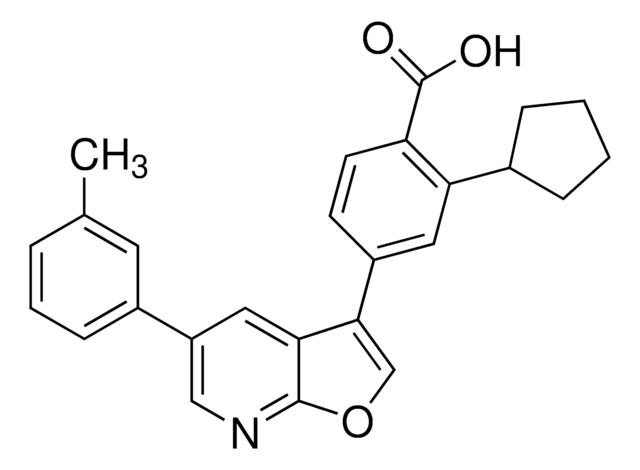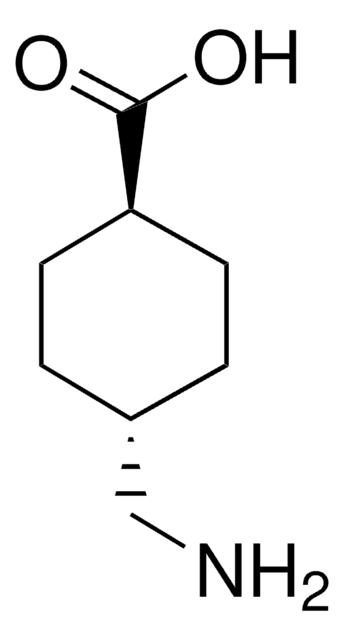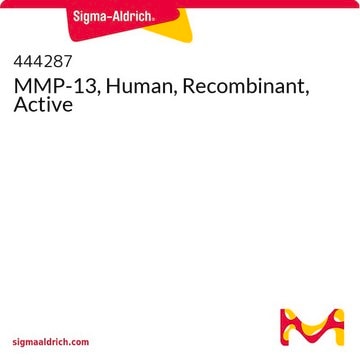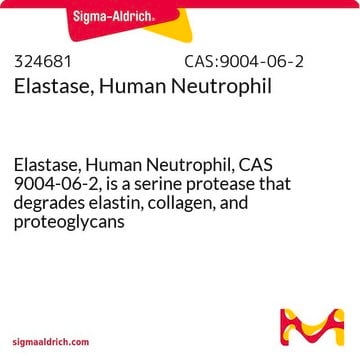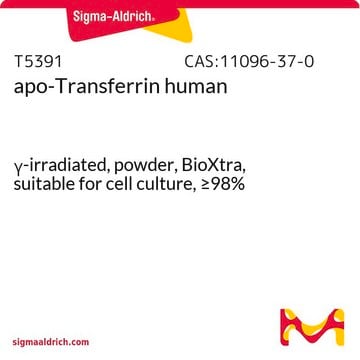CC1047
MMP-13, human, proform, his-tagged, E. coli recombinant
Synonym(s):
Procollagenase 3
Sign Into View Organizational & Contract Pricing
All Photos(1)
About This Item
UNSPSC Code:
12352204
eCl@ss:
32160405
NACRES:
NA.77
Recommended Products
biological source
human
Quality Level
Assay
>95% (total protein)
form
liquid
specific activity
250-300 mU/mg
manufacturer/tradename
Chemicon®
concentration
0.2 μg/μL
NCBI accession no.
UniProt accession no.
shipped in
dry ice
Gene Information
human ... MMP13(4322)
General description
CC1047 is a recombinant 452 amino acid polypeptide corresponding to human Pro-MMP-13, with an additional C-terminal His-tag with the sequence GVTHHHHHH expressed in E. coli and purified from periplasm. The calculated Mr of the recombinant protein is 51.681 kDa. Upon activation with APMA activated MMP-13 is formed.
Matrix metalloproteinases (MMPs) are Zn2+- and Ca2+-dependent endopeptidases which function in the turnover of extracellular matrix components [Matrisian, 1992]. Main subfamilies of MMP are collagenases, gelatinases, stromelysins and membrane-type matrix metalloproteinases [Nagase, 1997]. Three homologous collagenases have been identified in human tissues: Interstitial collagenase, neutrophil collagenase and collagenase-3. These three enzymes cleave fibrillar collagens at a single site, generating fragments of approximately ¾ and ¼ the size of the original molecules.
ProMMP-13 [Procollagenase-3] consists of 452 amino acids with a calculated Mr of 52.520 [Freije et al., 1994]. Due to N-linked glycosylation, the actual Mr is about 60000 Da [Knauper et al., 1996]. Within the protein the following domains and sequence regions can be distinguished [Freije et al., 1994; Knauper et al., 1996]: An N-terminal propeptide, which confers latency to the proenzyme, a Ca2+ and Zn2+-ion binding catalytic domain, a hinge region, and a C-terminal hemopexin-like domain. Latent procollagenase-3 can be activated by proteases such as stromelysin [ Knauper et al., 1996], gelatinase A, MT1-MMP and plasmin [ Knauper et al., 1996] or incubation with APMA Knauper et al., 1996]. The Mr of active collagenase-3 which begins with the N-terminal sequence YNVFPRTL is 48,000 Da.
Collagenase-3 hydrolyzes type II collagen 5- to 6- times faster than type I and type III collagens. The enzyme also exhibits high activity towards gelatin and it degrades SERPINS as a1-antichymotrypsin and plasminogen activator inhibitor-2 [Knauper et al., 1996]. Collagenase-3 is inhibited in a 1:1 stoichiometric fashion by TIMP-1, TIMP-2 and TIMP-3.
Collagenase-3 is expressed during fetal bone development [Stahlebackdahl, 1997]. In adult human tissues collagenase-3 has been detected only in pathological conditions: in malignant tumors [Freije et al., 1994], in chronic ulcers [Valaamo et al., 1997], in arthritic cartilage [Mitchell et al., 1996] and synovium [Wernicke et al., 1996].
ProMMP-13 [Procollagenase-3] consists of 452 amino acids with a calculated Mr of 52.520 [Freije et al., 1994]. Due to N-linked glycosylation, the actual Mr is about 60000 Da [Knauper et al., 1996]. Within the protein the following domains and sequence regions can be distinguished [Freije et al., 1994; Knauper et al., 1996]: An N-terminal propeptide, which confers latency to the proenzyme, a Ca2+ and Zn2+-ion binding catalytic domain, a hinge region, and a C-terminal hemopexin-like domain. Latent procollagenase-3 can be activated by proteases such as stromelysin [ Knauper et al., 1996], gelatinase A, MT1-MMP and plasmin [ Knauper et al., 1996] or incubation with APMA Knauper et al., 1996]. The Mr of active collagenase-3 which begins with the N-terminal sequence YNVFPRTL is 48,000 Da.
Collagenase-3 hydrolyzes type II collagen 5- to 6- times faster than type I and type III collagens. The enzyme also exhibits high activity towards gelatin and it degrades SERPINS as a1-antichymotrypsin and plasminogen activator inhibitor-2 [Knauper et al., 1996]. Collagenase-3 is inhibited in a 1:1 stoichiometric fashion by TIMP-1, TIMP-2 and TIMP-3.
Collagenase-3 is expressed during fetal bone development [Stahlebackdahl, 1997]. In adult human tissues collagenase-3 has been detected only in pathological conditions: in malignant tumors [Freije et al., 1994], in chronic ulcers [Valaamo et al., 1997], in arthritic cartilage [Mitchell et al., 1996] and synovium [Wernicke et al., 1996].
Application
ACTIVATION:
An aliquot of 19.5 μL procollagenase-3 is mixed with 0.5 μL APMA solution (40 mM p-aminophenyl mercuric acetate in DMSO) and the mixture is incubated for 30 minutes at 37°C. The mixture may be stored on ice until use for activity assays.
INHIBITORS:
MMP-13 is inhibited by TIMPs and by chelators of divalent cations such as EDTA or o-phenanthroline.
An aliquot of 19.5 μL procollagenase-3 is mixed with 0.5 μL APMA solution (40 mM p-aminophenyl mercuric acetate in DMSO) and the mixture is incubated for 30 minutes at 37°C. The mixture may be stored on ice until use for activity assays.
INHIBITORS:
MMP-13 is inhibited by TIMPs and by chelators of divalent cations such as EDTA or o-phenanthroline.
Unit Definition
Specific Activity: where 1 U is the activity that hydrolyzes 1 μmol peptide (7-methoxycoumarin-4-yl)acetyl-Pro-Leu-Gly-Leu-Dpa-Ala-Arg) within 1 minute (Knight, 1992).
Physical form
Provided as a liquid in 50 mM Tris-HCl, pH 7.5, 150 mM NaCl, 5 mM CaCl2, 0.05% Brij-35.
Storage and Stability
Maintain frozen at -70°C in undiluted aliquots. The enzyme may be stored at -20°C for several weeks without significant loss of activity. Repeated freezing and thawing should be avoided.
Analysis Note
Pro-MMP-13 appears as a major band at about 60 kDa in SDS-PAGE
Legal Information
CHEMICON is a registered trademark of Merck KGaA, Darmstadt, Germany
Disclaimer
Unless otherwise stated in our catalog or other company documentation accompanying the product(s), our products are intended for research use only and are not to be used for any other purpose, which includes but is not limited to, unauthorized commercial uses, in vitro diagnostic uses, ex vivo or in vivo therapeutic uses or any type of consumption or application to humans or animals.
Storage Class Code
12 - Non Combustible Liquids
WGK
WGK 1
Flash Point(F)
Not applicable
Flash Point(C)
Not applicable
Certificates of Analysis (COA)
Search for Certificates of Analysis (COA) by entering the products Lot/Batch Number. Lot and Batch Numbers can be found on a product’s label following the words ‘Lot’ or ‘Batch’.
Already Own This Product?
Find documentation for the products that you have recently purchased in the Document Library.
Characterization of an exosite binding inhibitor of matrix metalloproteinase 13.
Lata T Gooljarsingh,Ami Lakdawala,Frank Coppo,Lusong Luo,Gregg B Fields,Peter J Tummino et al.
Protein Science null
Collagenase-3 (MMP-13) is expressed during human fetal ossification and re-expressed in postnatal bone remodeling and in rheumatoid arthritis.
St?hle-Backdahl, M, et al.
Laboratory Investigation; a Journal of Technical Methods and Pathology, 76, 717-728 (1997)
Cloning of collagenase 3 from the synovial membrane and its expression in rheumatoid arthritis and osteoarthritis.
Wernicke, D, et al.
The Journal of Rheumatology, 23, 590-595 (1996)
Activation mechanisms of matrix metalloproteinases.
Nagase, H
Biological Chemistry, 378, 151-160 (1997)
P G Mitchell et al.
The Journal of clinical investigation, 97(3), 761-768 (1996-02-01)
Proteolysis of triple-helical collagen is an important step in the progression toward irreversible tissue damage in osteoarthritis. Earlier work on the expression of enzymes in cartilage suggested that collagenase-1 (MMP-1) contributes to the process. Degenerate reverse transcription polymerase chain reaction
Our team of scientists has experience in all areas of research including Life Science, Material Science, Chemical Synthesis, Chromatography, Analytical and many others.
Contact Technical Service